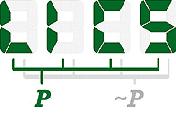Paper: Higher-order narrowing (at LICS 1994)
Authors: Christian PrehoferAbstract
Introduces several approaches for solving higher-order equational problems by higher-order narrowing, and gives some completeness results. The results apply to higher-order functional-logic programming languages and to higher-order unification modulo a higher-order equational theory. We lift the general notion of first-order narrowing to so-called higher-order patterns and argue that the full higher-order case is problematic. Integrating narrowing into unification (called `lazy narrowing') can avoid these problems and can be adapted to the full higher-order case. For the second-order case, we develop a version where the needed second-order unification remains decidable. Finally, we discuss a method that combines both approaches by using narrowing on higher-order patterns with full higher-order constraints
BibTeX
@InProceedings{Prehofer-Higherordernarrowin,
author = {Christian Prehofer},
title = {Higher-order narrowing},
booktitle = {Proceedings of the Ninth Annual IEEE Symp. on Logic in Computer Science, {LICS} 1994},
year = 1994,
editor = {Samson Abramsky},
month = {July},
pages = {507--516},
location = {Paris, France},
publisher = {IEEE Computer Society Press}
}
